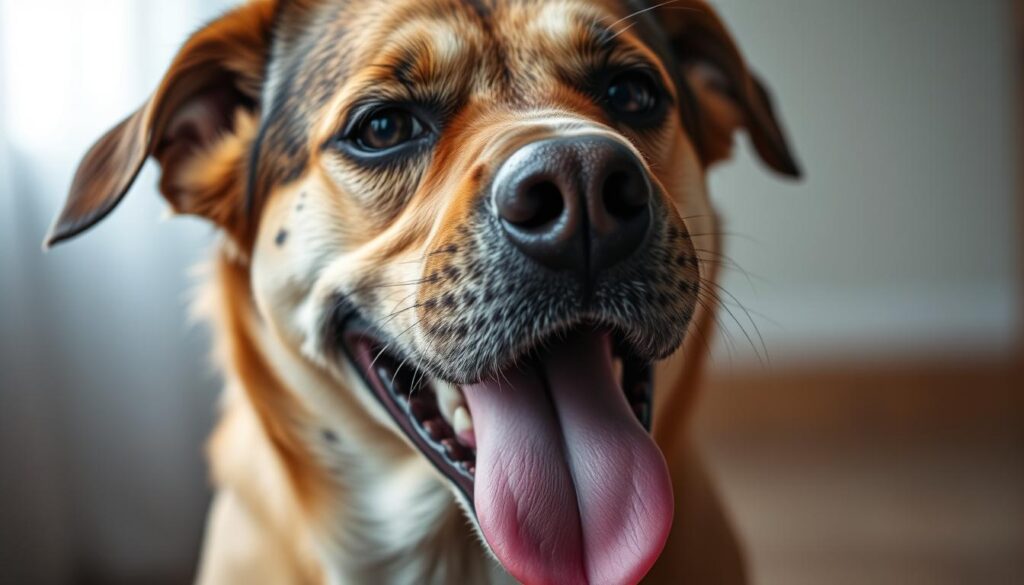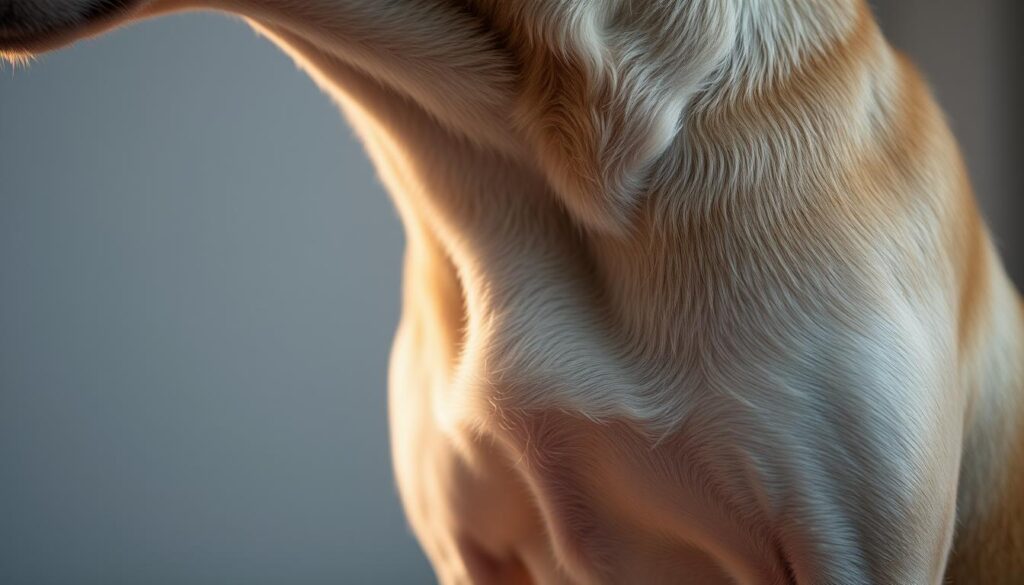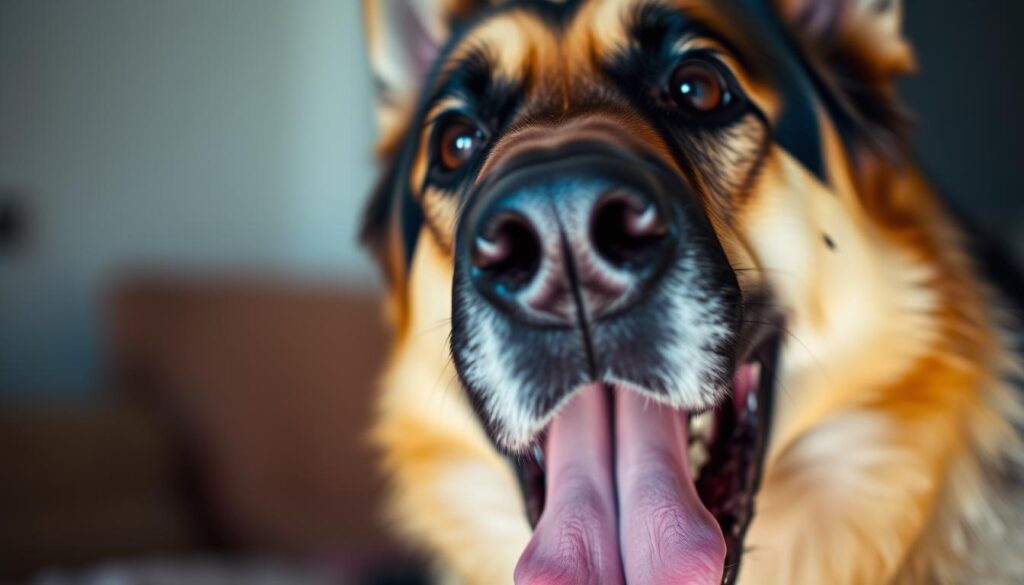If you own a dog, you’ve probably heard them breathe heavily after exercise. But when should you worry about this? Knowing how dogs breathe is key for any owner. It’s important to know when their heavy breathing is normal or a sign of a problem.

Heavy breathing can be a natural response to exercise or stress in dogs. But it can also mean there’s a serious health issue. Learning about dog breathing helps you know when to worry. By recognizing the signs and understanding the causes, you can keep your dog healthy.
Key Takeaways
- Heavy dog breathing can be a normal response to physical activity or a sign of an underlying issue
- Understanding the causes of heavy breathing in dogs is crucial for dog owners
- Dog breathing heavy can be a symptom of a serious health issue
- Recognizing the signs of heavy breathing in dogs is essential for taking prompt action
- Regular monitoring of your dog’s breathing can help identify potential health issues early on
- Consulting with a veterinarian is the best way to determine the cause of heavy breathing in dogs
Understanding Normal Dog Breathing Patterns
As a dog owner, knowing normal breathing patterns is key. This helps spot problems early. Dogs breathe 10 to 30 times a minute, based on age, size, and breed. Panting in dogs is common, especially after exercise or in the heat, to cool down.
It’s important to tell normal panting from dog labored breathing. Labored breathing means quick, shallow breaths and might include coughing or wheezing. If you see these signs, see a vet to check for health issues.
Normal Respiratory Rate in Dogs
A healthy dog breathes 10 to 30 times a minute. This rate goes up during exercise, excitement, or in the heat. For example:
- Puppies: 15 to 40 breaths per minute
- Small breeds: 15 to 30 breaths per minute
- Medium breeds: 10 to 25 breaths per minute
- Large breeds: 8 to 20 breaths per minute
Different Types of Dog Breathing
Dogs breathe in different ways, like panting, sniffing, and relaxed breathing. Panting in dogs is normal when they’re active, hot, or stressed. Relaxed breathing is slow and deep.

When Panting is Normal
Panting in dogs is okay when they’re active, hot, or stressed. But if your dog pants too much or breathes hard, get vet help. This is to check for health problems.
Why is My Dog Breathing Heavy?
As a dog owner, it’s natural to worry when you notice your dog breathing heavily. Heavy breathing in dogs can be caused by various factors. This includes physical activity and medical conditions. You might see your dog panting after a walk or playtime, which is normal.
If your dog is breathing heavily without a reason, it’s important to find out why. Some common reasons include exercise and physical activity, which can increase respiratory rates. Heat and temperature issues can also cause heavy breathing. Additionally, anxiety and stress can make dogs breathe heavily, as can certain medical conditions.
Here are some possible reasons for heavy breathing in dogs:
- Physical activity and exercise
- Heat and temperature-related issues
- Anxiety and stress
- Medical conditions, such as respiratory infections or heart disease

Understanding the causes of heavy breathing in dogs is vital. By recognizing the signs and symptoms, you can address the issue. This ensures your dog’s health and well-being. If you’re concerned, always consult with a veterinarian for advice.
Common Causes of Heavy Breathing in Dogs
As a dog owner, it’s key to know why your pet might breathe heavily. Heavy breathing can mean there’s a bigger issue. Spotting the cause early can help a lot.
There are many reasons dogs might breathe hard. These include exercise, heat, anxiety, and health problems. Watching your dog closely is very important.
Exercise and Physical Activity
Exercise makes dogs breathe harder. It’s because their body needs more oxygen. But, if your dog is too heavy or has health issues, it can make breathing harder.
Heat and Temperature Related Issues
Heat can also make dogs breathe hard. They can get too hot, especially in warm weather. Keeping your dog cool is very important.
Anxiety and Stress
Anxiety and stress can make dogs breathe harder too. If your dog is anxious, their breathing can speed up. Finding out what’s stressing them and reducing it is key.
Medical Conditions
Health problems can also cause heavy breathing. Issues like heart disease or lung problems can make breathing hard. If you think your dog has a health issue, see a vet right away.
Breed-Specific Breathing Issues
As a dog owner, knowing about your dog’s breathing issues is key. Some breeds face breathing problems more often. For example, Pugs and Bulldogs can wheeze because of their narrow airways.
Some breeds are more likely to have breathing troubles. Here are a few examples:
- Brachycephalic breeds, like Pugs and Bulldogs, have trouble breathing because of their short nasal passages.
- Large and giant breeds, such as Great Danes and Mastiffs, might wheeze because of their big lung capacity.
Watching your dog’s breathing is important, especially if they’re at risk. Knowing about these issues helps you prevent and manage them. This can lower the chance of dog wheezing and other breathing problems.
Regular vet visits are crucial. They can spot breathing issues early. This way, you can protect your dog’s breathing health. With your vet’s help, you can keep your dog happy and healthy.
Emergency Signs of Respiratory Distress
As a dog owner, it’s vital to know the emergency signs of respiratory distress in your pet. Fast breathing in dogs can signal a serious issue that needs quick action. If you see your dog showing any of these signs, get vet help fast.
Some key signs include blue or purple gums, which show a lack of oxygen. Excessive drooling can also mean trouble, as dogs may struggle to breathe and drool a lot. Also, fast breathing in dogs is a warning sign, and watching your dog’s breathing is crucial.
- Blue or purple gums
- Excessive drooling
- Fast breathing in dogs
- Difficulty breathing
- Coughing or wheezing
If you see these signs, call your vet right away. Quick vet care can greatly improve your dog’s chances of recovery.
As a dog owner, you’re key in spotting respiratory distress signs and getting help. Knowing these signs and acting fast can help your dog get the care they need to recover from fast breathing and other issues.
| Signs of Respiratory Distress | What to Do |
|---|---|
| Blue or purple gums | Seek veterinary help immediately |
| Excessive drooling | Seek veterinary help immediately |
| Fast breathing in dogs | Seek veterinary help immediately |
Diagnosing Dog Breathing Problems
As a dog owner, it’s key to know how to diagnose breathing issues in dogs. If you see excessive panting in dogs, it’s time to see a vet. They will check your dog’s health and might do more tests.
The vet will look at your dog’s symptoms, like excessive panting in dogs. They might do a physical check, ask about your dog’s health history, and run tests. These could be chest X-rays, blood tests, or a lung exam.
Some tests used to check breathing problems include:
- Chest X-rays to look at the lungs and heart
- Blood work to find any health issues
- Respiratory exam to check lung health
- Arterial blood gas analysis to check oxygen levels
Knowing how to diagnose breathing issues helps you help your dog. If you worry about your dog’s breathing, see a vet fast.
| Diagnostic Test | Purpose |
|---|---|
| Chest X-rays | To evaluate the lungs and heart |
| Blood work | To check for underlying medical conditions |
| Respiratory exam | To assess lung function |
| Arterial blood gas analysis | To evaluate oxygen levels |
Treatment Options for Heavy Breathing
As a dog owner, knowing about dog breathing heavy and heavy breathing in dogs is key. The right treatment depends on why your dog is breathing hard. If your dog is having trouble breathing, seeing a vet is a must.
There are three main ways to treat dog breathing heavy. These are medical help, home care, and lifestyle changes. Medical help might include medicines for heart or lung problems. Home care means keeping your dog cool and giving them lots of water.
Medical Interventions
- Medication to manage underlying conditions
- Oxygen therapy to help increase oxygen levels in the blood
- Surgery to correct any underlying anatomical issues
Home Care Methods
- Providing a cool, comfortable environment
- Ensuring access to plenty of fresh water
- Using a humidifier to help soothe the respiratory system
Lifestyle Changes
Changing your dog’s lifestyle can also help. This includes regular walks, keeping them at a healthy weight, and avoiding extreme weather. With your vet’s help, these changes can make your dog breathe better and live a happier life.
| Treatment Option | Description |
|---|---|
| Medical Interventions | Medication, oxygen therapy, surgery |
| Home Care Methods | Providing a cool environment, fresh water, humidifier |
| Lifestyle Changes | Regular exercise, healthy weight, avoiding extreme temperatures |
Preventing Respiratory Issues in Dogs
As a dog owner, you want your pet to be healthy and happy. Preventing respiratory issues is crucial. Panting in dogs can signal a problem, so it’s important to act early.
Regular exercise is key for your dog’s health, including their lungs. It keeps their lungs strong and healthy. Also, a healthy weight is important to avoid lung strain.
Environmental Considerations
Environmental factors can also affect your dog’s health. Pollution and second-hand smoke can lead to panting in dogs. Here’s how to reduce these risks:
- Keep your home clean and free from pollutants
- Avoid smoking near your dog
- Provide a well-ventilated area for your dog to exercise
By taking these steps, you can lower the risk of respiratory issues. This helps your dog stay healthy and happy. Remember, prevention is key to a long, healthy life for your dog.
Long-term Management Strategies
As a dog owner, managing your dog’s labored breathing is a long-term job. You need to work closely with your vet to create a plan that fits your dog’s needs. By keeping an eye on your dog’s health and making lifestyle changes, you can ease their dog labored breathing and enhance their life quality.
Some important long-term management strategies include:
- Regular exercise, tailored to your dog’s abilities and health status
- Weight management, to reduce the strain on your dog’s respiratory system
- Environmental considerations, such as providing a cool, comfortable living space
By following these strategies and getting advice from your vet, you can help your dog manage
Remember, every dog is unique, and your approach should match your dog’s needs and situation. With patience, dedication, and the right guidance, you can help your dog live well despite dog labored breathing.
When to Seek Professional Help
As a dog owner, it’s key to know when your pet has dog breathing problems or dog respiratory distress. Look out for signs like rapid breathing, panting, or coughing. If you see these, get help right away.
Some signs that mean your dog needs urgent vet care include:
- Blue or purple gums
- Excessive drooling
- Difficulty breathing or rapid breathing
If you see these signs, call your vet or a local animal hospital fast. They can tell you what to do next and if your dog needs help now.
For dogs with ongoing dog breathing problems or dog respiratory distress, seeing a respiratory specialist is a good idea. These experts can find and treat issues like asthma or chronic bronchitis. They can also give your dog care tailored to their needs.
Acting quickly is very important for dog breathing problems and dog respiratory distress. Getting professional help when needed can help your dog get the best care. This can greatly improve their chances of getting better.
Conclusion
Understanding “dog breathing heavy” is key for your dog’s health. Knowing normal breathing and common causes of heavy breathing is important. This knowledge helps you keep your dog happy and healthy.
Regular vet visits, a healthy weight, and a stress-free home are crucial. These steps help prevent and manage breathing issues in dogs. By being proactive, you protect your pet’s breathing and ensure a great life for them.
Your dog’s breathing is a vital sign. If you see any changes or signs of distress, get help from a vet right away. With the right knowledge and care, you can handle your dog’s breathing health confidently.
FAQ
What is considered normal dog breathing?
A dog’s normal breathing rate is between 12 to 35 breaths per minute. Different breathing patterns, like panting, are normal. They happen when dogs exercise or get hot. It’s key to know when your dog’s breathing is not normal.
Why is my dog breathing heavily?
There are many reasons for heavy breathing in dogs. It could be from exercise, heat, anxiety, or health issues. Knowing the reasons can help you figure out if it’s okay or if you need to see a vet.
What are some common causes of heavy breathing in dogs?
Heavy breathing can be caused by exercise, heat, anxiety, or health problems. Knowing what triggers it can help you see if it’s normal or if it’s a sign of a bigger issue.
Are there any breed-specific breathing issues I should be aware of?
Yes, some dog breeds are more likely to have breathing problems. For example, pugs and bulldogs might have trouble breathing. Knowing about these issues can help you keep an eye on your dog’s health.
When should I call the vet for my dog’s heavy breathing?
Call the vet right away if your dog shows signs of trouble breathing. Look for blue or purple gums, lots of drool, or fast breathing. These are signs of a serious problem that needs quick attention.
How do vets diagnose dog breathing problems?
Vets use a physical exam, medical history, and sometimes tests like X-rays or blood work. They look at symptoms like panting to find the cause of breathing issues.
What are the treatment options for heavy breathing in dogs?
Treatment for heavy breathing can include medicine, home care, and lifestyle changes. Your vet might prescribe meds, suggest changes to your dog’s environment, or recommend exercise adjustments.
How can I prevent respiratory issues in my dog?
To prevent breathing problems, keep your dog active, at a healthy weight, and consider their environment. Taking these steps can help lower the risk of breathing issues.
How do I manage chronic breathing issues in my dog long-term?
For dogs with chronic breathing problems, managing it long-term is key. This means watching their health closely, making lifestyle changes, and working with your vet to improve their quality of life.
When should I seek professional help for my dog’s breathing problems?
Seek vet help if you notice signs of trouble breathing, like hard breathing, fast breathing, or changes in gum color. Quick action is important to address any health issues.
